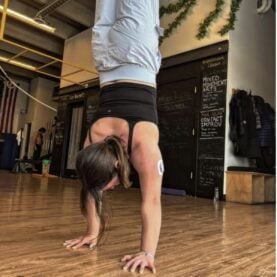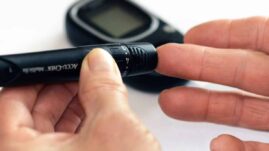How I found balance in managing my Type 1 Diabetes and recovering from an eating disorder by learning how to do a handstand and finding community.

I never thought about doing a handstand until I was 22 years old, two decades after I was diagnosed with Type 1 Diabetes.
I was working at the CU Boulder Recreation Center as a personal trainer when my boss invited me to try her new handstand class. Never one to turn my nose up at the possibility of adventure, I eagerly accepted the invitation.
That first class was tough. My hands fought the floor like a toddler taking her first steps. The motion of kicking myself upside down and wholeheartedly trusting in my hands to balance my entire body was terrifying.
The only drill I excelled at was the hollow hold we did at the beginning of class to strengthen our core, during which we laid on the floor. From there, I felt increasingly uncoordinated, oafish, and out of my element.
By the end of class, I was a stranger inside my own body, which, looking back, is perhaps why I went back to try again.
As a Type 1 Diabetic, feeling like an outsider inside my body was familiar.
When the knock came upon the door, I knew it was over.
“Claire? It’s your Resident Advisor, Giselle. Can you please let me in?”
I didn’t move from the dorm bed I’d laid in for the past two days.
“Claire, I’m with some ladies from health services. We’re going to unlock your door.”
I stared up at the ceiling tiles, counting them.
I’d moved into my dorm at The College of New Jersey three days before. I’d been pretending I didn’t have T1D for over two years before that. I skipped insulin doses to control my weight, and I was terrified of eating most food.
The first morning after moving into college, I went with all the other freshmen to the dining hall. What should’ve been a simple task turned into a nightmare.
I ate a bowl of granola, and underestimated my insulin bolus to prevent my blood sugar from going low. Within minutes, my blood sugar spiked up to over 500 mg/dl.
As my classmates filed out of the dining hall to the first of the day’s activities, I was so nauseous I went to the bathroom.
As I sat on the bathroom floor, my runaway thoughts wrapped around my mind like poison ivy.
If I couldn’t manage my T1D, how was I supposed to go to class, make friends, or do anything at all?
My worst suspicions were confirmed. I was incapable of taking care of myself; of being worth anything at all. I went to bed, and there I stayed until the knock came upon the door.
It wasn’t the first knock at the door I’d heard. My friends and family had been knocking on the door for months. Yet, as you can only lead a horse to water, you can only hope to beat down the door– and then what?
In the days before CGMs and insulin pumps, my daily routine consisted of finger pricks, blood drops, syringes, insulin vials, and over 120 extra T1D-related decisions per day.
I still have trouble fathoming how my mom did all of this and more for me through my toddler and elementary school years. She’s unarguably a hero.
In middle school I took over my T1D management, which also happened to be the time I was becoming more aware of my body. The scale and the glucose meter; the numbers these machines showed became the all-powerful dictators of my self-worth.
I strove for perfection, and there is nothing less perfect than T1D management.
The higher numbers made me feel anxious, and then depressed. I began to give up.
I could’ve asked my mom for help, but I felt too ashamed about my spiraling situation. I lied about my blood sugars, and told mom and the school nurse that they were in range as they consistently crept up over 300 mg/dl.
It was my dirty little secret; an unbridled snowball of self-destruction and shame that gained size and speed with each passing day. So, I decided to slow everything down.
When I was 11 years old, I stopped eating.
Cutting food out of my life was effective, even euphoric, for a couple of weeks. My blood sugars stayed in range as my meals shrunk. Temporarily, I found balance in control.
However, control is not sustainable, and the scales quickly tipped toward the extreme. Control began to look like eating an orange and three tablespoons of oatmeal for an entire day, shoving chicken from a stirfry into my socks at the dinner table so my mom wouldn’t notice I wasn’t eating, and staring at pictures of food I couldn’t let myself eat for hours on the internet.
Control carved me into a hardened, hollow shell of the joyful kid I’d been weeks before.
People with T1D are twice as likely to develop an eating disorder than a person without T1D. The enormous amount of focus T1D management demands upon numbers and food, combined with our culture’s obsession with weight, mixes together to form a potent concoction of shame and guilt surrounding one’s body and the food they put into it.
I spent my adolescent years in and out of hospital eating disorder clinics and therapist’s offices, but nothing worked.
My high school years were a marathon of denying my T1D existed, feeding into my eating disorder, and falling deeper and deeper into a hole where, in the darkness, I learned to rely upon self-harm for relief.
It was upon this foundation I moved to college to live alone and take care of myself.
After three knocks, campus mental health services unlocked my dorm room door and saw enough to decide I didn’t know if I wanted to be alive anymore.
I don’t remember that ambulance ride from my dorm building to the emergency room. I was in shock from how out of balance my life had become.
That knock on the door marked an ending and, therefore, a new beginning.
The day I reached my 60-second handstand hold goal, it felt anticlimactic.
“Oh, whoa,” I mumbled as the metronome struck the 60th second.
I remember hugging my friend Carla and coach Matt. I remember how, once the initial excitement wore off, I was left with the solemn acknowledgment that the achievement of this goal didn’t make me feel any different or better than a minute before.
The change had already taken place over the course of days after days of consistent handstand drills and practice, encouragement from my coaches and friends, and the 8, 15, 30, 38, 47, 44, 50, 54 second holds that came before.
Each day of commitment to taking care of myself and practicing my handstand chipped away at a granite boulder of self-fear, like a slow, relentless drip out of a water tap.
My newfound balance was chiseled out of the fear of what I could be capable of if I gave myself a chance.
After that knock fell upon my dorm room door, I dropped out of college.
I eventually found my way back to a healthier version of myself during a culmination of days after days of calculating my insulin doses and confronting my issues with food, as well as some major changes, such as getting a continuous glucose monitor and swapping insulin pens for an insulin pump.
After a few months, I went back to school, became a personal trainer, and eventually found my way to handstand class because I’ve learned there is nothing more valuable in life than community.
There is no 60-second milestone in T1D management. There is no moment where the beat of the metronome announces you’ve accomplished something and can check that goal off the list.
Every day, I wake up, and I must choose to take care of myself and to answer that knock on the door.
This choice is easy when you surround yourself with people who care about you. In college, I found community on an intramural soccer team and a club I started for type 1 diabetic students. Most recently, I’ve made lifelong friends in handstand class.
Today, I choose to give myself a chance. I choose to take my insulin, eat a variety of food, and indulge in community and movement.
I’ve found that without any one of these things my life becomes extremely out of balance, and my very being tilts off its axis.
The paradox of eating disorder recovery and type 1 diabetes management is a formidable knot that we must continue to research and find a way to begin to unravel.
In order to hold a handstand, you must maintain a strong bodyline. This means staying engaged in your core to connect your arms and legs in one tight line through your hips.
When your bodyline breaks, your legs fall either over or behind your hands, and you lose your balance. Unless you can shift the weight in your hands quickly, you will fall.
Luckily, T1D management has taught me to get up and try again.





Tracee Jones
This is such an inspiring read! I love how you’ve connected the discipline of handstands with the balance required in managing Type 1 diabetes — it’s a powerful metaphor for both physical and mental strength.